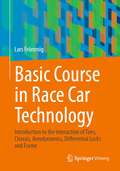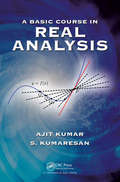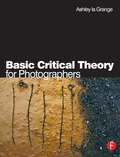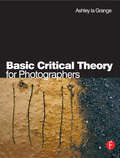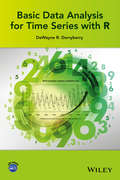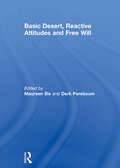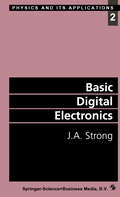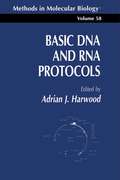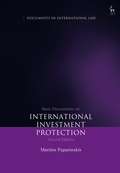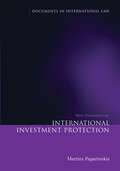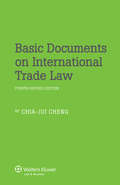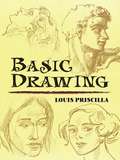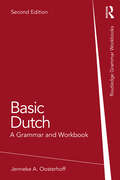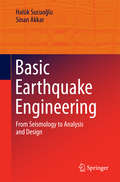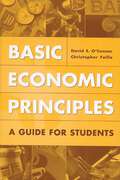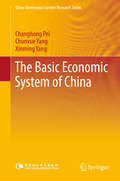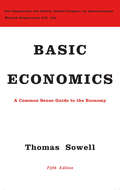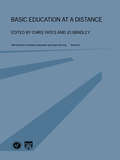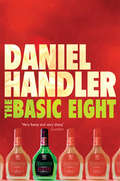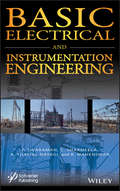- Table View
- List View
Basic Course in Race Car Technology: Introduction to the Interaction of Tires, Chassis, Aerodynamics, Differential Locks and Frame
by Lars FrömmigThe focus of the book is on the driving dynamics of racing vehicles. The interaction of the tyre, the aerodynamics, of the chassis and the limited slip differential specific to racing vehicles is dealt with. A chapter on the basics of vehicle dynamics makes it possible to get started with this topic even without prior automotive engineering training. A historical review and a consideration of the essential safety aspects create an understanding of higher-level requirements, which are specified, for example, by the technical regulations.
A Basic Course in Real Analysis
by Ajit KumarBased on the authors' combined 35 years of experience in teaching, A Basic Course in Real Analysis introduces students to the aspects of real analysis in a friendly way. The authors offer insights into the way a typical mathematician works observing patterns, conducting experiments by means of looking at or creating examples, trying to understand t
Basic Critical Theory for Photographers
by Ashley la GrangeBasic Critical Theory for Photographers generates discussion, thought and practical assignments around key debates in photography. Ashley la Grange avoids the trap of an elitist and purely academic approach to critical theory, taking a dual theoretical and practical approach when considering the issues. Key critical theory texts (such as Sontag's 'On Photography' and Barthes' 'Camera Lucida') are clarified and shortened. La Grange avoids editorilising, letting the arguments develop as the writers had intended; it is the assignments which call into question each writer's approach and promote debate.This is the ideal book if you want to understand key debates in photography and have a ready-made structure within which to discuss and explore these fascinating issues. It is accessible to students, from high school to university level, but will also be of interest to the general reader and to those photographers whose training and work is concerned with the practical aspects of photography.Also includes invaluable glossary of terms and a substantial index that incorporates the classic texts, helping you to navigate your way through these un-indexed works. The book also contains useful information on photo-mechanical processes, explaining how a photograph can appear very differently, and as a result be interpreted in a range of ways, in a variety of books.
Basic Critical Theory for Photographers
by Ashley la GrangeBasic Critical Theory for Photographers generates discussion, thought and practical assignments around key debates in photography. Ashley la Grange avoids the trap of an elitist and purely academic approach to critical theory, taking a dual theoretical and practical approach when considering the issues. Key critical theory texts (such as Sontag's 'On Photography' and Barthes' 'Camera Lucida') are clarified and shortened. La Grange avoids editorilising, letting the arguments develop as the writers had intended; it is the assignments which call into question each writer's approach and promote debate.This is the ideal book if you want to understand key debates in photography and have a ready-made structure within which to discuss and explore these fascinating issues. It is accessible to students, from high school to university level, but will also be of interest to the general reader and to those photographers whose training and work is concerned with the practical aspects of photography.Also includes invaluable glossary of terms and a substantial index that incorporates the classic texts, helping you to navigate your way through these un-indexed works. The book also contains useful information on photo-mechanical processes, explaining how a photograph can appear very differently, and as a result be interpreted in a range of ways, in a variety of books.
Basic Data Analysis for Time Series with R
by DeWayne R. DerryberryWritten at a readily accessible level, Basic Data Analysis for Time Series with R emphasizes the mathematical importance of collaborative analysis of data used to collect increments of time or space. Balancing a theoretical and practical approach to analyzing data within the context of serial correlation, the book presents a coherent and systematic regression-based approach to model selection. The book illustrates these principles of model selection and model building through the use of information criteria, cross validation, hypothesis tests, and confidence intervals. Focusing on frequency- and time-domain and trigonometric regression as the primary themes, the book also includes modern topical coverage on Fourier series and Akaike's Information Criterion (AIC). In addition, Basic Data Analysis for Time Series with R also features: Real-world examples to provide readers with practical hands-on experience Multiple R software subroutines employed with graphical displays Numerous exercise sets intended to support readers understanding of the core concepts Specific chapters devoted to the analysis of the Wolf sunspot number data and the Vostok ice core data sets
Basic Data Analysis for Time Series with R
by DeWayne R. DerryberryWritten at a readily accessible level, Basic Data Analysis for Time Series with R emphasizes the mathematical importance of collaborative analysis of data used to collect increments of time or space. Balancing a theoretical and practical approach to analyzing data within the context of serial correlation, the book presents a coherent and systematic regression-based approach to model selection. The book illustrates these principles of model selection and model building through the use of information criteria, cross validation, hypothesis tests, and confidence intervals. Focusing on frequency- and time-domain and trigonometric regression as the primary themes, the book also includes modern topical coverage on Fourier series and Akaike's Information Criterion (AIC). In addition, Basic Data Analysis for Time Series with R also features: Real-world examples to provide readers with practical hands-on experience Multiple R software subroutines employed with graphical displays Numerous exercise sets intended to support readers understanding of the core concepts Specific chapters devoted to the analysis of the Wolf sunspot number data and the Vostok ice core data sets
Basic Desert, Reactive Attitudes and Free Will
by Maureen Sie and Derk PereboomBasic Desert, Reactive Attitudes and Free Will addresses the issue of whether we can make sense of the widespread conviction that we are morally responsible beings. It focuses on the claim that we deserve to be blamed and punished for our immoral actions, and how this claim can be justified given the philosophical and scientific reasons to believe that we lack the sort of free will required for this sort of desert. Contributions to the book distinguish between, and explore, two clusters of questions. The first asks what it is to deserve to be harmed or benefitted. What are the bases for desert – actions, good character, bad character, the omission of good character traits? The second cluster explores the disagreement between compatabilists and incompatibilists surrounding the nature of desert. Do we deserve to be harmed, benefitted, or judged, even if we lack the ability to act differently, and if we do not, what effect does this have on our everyday actions? Taken in full, this book sheds light on the notion of desert implicated in our practice of holding each other morally responsible. This book was originally published as a special issue of Philosophical Explorations.
Basic Desert, Reactive Attitudes and Free Will
by Maureen Sie Derk PereboomBasic Desert, Reactive Attitudes and Free Will addresses the issue of whether we can make sense of the widespread conviction that we are morally responsible beings. It focuses on the claim that we deserve to be blamed and punished for our immoral actions, and how this claim can be justified given the philosophical and scientific reasons to believe that we lack the sort of free will required for this sort of desert. Contributions to the book distinguish between, and explore, two clusters of questions. The first asks what it is to deserve to be harmed or benefitted. What are the bases for desert – actions, good character, bad character, the omission of good character traits? The second cluster explores the disagreement between compatabilists and incompatibilists surrounding the nature of desert. Do we deserve to be harmed, benefitted, or judged, even if we lack the ability to act differently, and if we do not, what effect does this have on our everyday actions? Taken in full, this book sheds light on the notion of desert implicated in our practice of holding each other morally responsible. This book was originally published as a special issue of Philosophical Explorations.
Basic Digital Electronics (Physics and Its Applications)
by J. A. StrongModern electronics is the most visible result of research in solid state physics. Transistors and integrated circuits are used everywhere in ever increasing numbers. The microprocessor controlled coffee-pot exists. Most experimental physicists, and, indeed, experimental scientists in most disciplines, study their subject with the aid of apparatus containing significant amounts of electronics and much of that electronics is digital. In order to design experiments and apparatus or simply to understand how a piece of equipment works, an under standing of electronics has become increasingly important. In recognition that electronics has pervaded so many areas, courses in digital electronics are now a recommended part of physics and many other science degree courses. At the introductory level, digital electronics is, primarily, a practical subject with relatively few basic concepts and any complex ity arises from the coupling together of many simple circuits and the extensive use of feedback. Designing an electronic circuit and then getting it to work correctly provides an experience, and a sense of achievement, which is significantly different from most undergradu ate work as it more closely resembles project work than standard laboratory practicals.
Basic Documents on International Investment Protection (Documents in International Law)
by Martins PaparinskisInternational law of foreign investment is a field of public international law that has attracted considerable attention from practitioners, academics, and policy-makers in the last two decades. Its key characteristic is the extent of substantive and procedural decentralisation: while often sharing certain structural elements, both substantive obligations and mechanisms of international dispute settlement are mostly opposable only between the particular parties, even when expressed in multilateral form. This makes a clear and comprehensive overview of the topic particularly important. The second edition adopts a new structure that better reflects the concurrence of various reform proposals with the fairly stable stratum of instruments that inform the current practice. With this systemic dynamic in mind, the selected documents are divided into three parts: Past, Present, and Future. The Past sets out the legal background to modern investment protection law. The Present provides generalist international law materials (sources and responsibility), a selection of the more important instruments with substantive investment rules, and rules of international dispute settlement regarding investment protection. The Future (new for the second edition) lists a number of possible directions of future development, including a variety of approaches that maintain the traditional procedural kernel of investor-State arbitration as well as proposals for more significant change, with non-State actor involvement in dispute settlement either rejected or moulded into a judicial mechanism. This highly regarded book is aimed at teachers, students, practitioners, and policymakers in the area. It can be used both as a practitioners' handbook and as a classroom companion for courses on international dispute settlement and investment protection law.
Basic Documents on International Investment Protection: (fifth Edition) (Documents in International Law)
by Martins PaparinskisInternational law of foreign investment is a field of public international law that has attracted considerable attention from practitioners, academics, and policy-makers in the last two decades. Its key characteristic is the extent of substantive and procedural decentralisation: while often sharing certain structural elements, both substantive obligations and mechanisms of international dispute settlement are mostly opposable only between the particular parties, even when expressed in multilateral form. This makes a clear and comprehensive overview of the topic particularly important. The second edition adopts a new structure that better reflects the concurrence of various reform proposals with the fairly stable stratum of instruments that inform the current practice. With this systemic dynamic in mind, the selected documents are divided into three parts: Past, Present, and Future. The Past sets out the legal background to modern investment protection law. The Present provides generalist international law materials (sources and responsibility), a selection of the more important instruments with substantive investment rules, and rules of international dispute settlement regarding investment protection. The Future (new for the second edition) lists a number of possible directions of future development, including a variety of approaches that maintain the traditional procedural kernel of investor-State arbitration as well as proposals for more significant change, with non-State actor involvement in dispute settlement either rejected or moulded into a judicial mechanism. This highly regarded book is aimed at teachers, students, practitioners, and policymakers in the area. It can be used both as a practitioners' handbook and as a classroom companion for courses on international dispute settlement and investment protection law.
Basic Documents on International Investment Protection (Documents in International Law)
by Martins PaparinskisThe increase in the number and complexity of investor-State treaty arbitrations in the last decade has attracted considerable attention from practitioners and academics of international investment protection law. Rules aimed at regulating the protection of foreign investment have been expressed in a decentralised manner, making a clear and comprehensive overview of the topic important. This volume focuses on the relevant documents and aims to provide an exhaustive treatment of relevant procedural and substantive issues. It includes documents explaining the historical development of investment law, substantive investment rules (multilateral and bilateral treaties and model documents, and general rules on the law of treaties and responsibility) and procedural investment rules (relating to the arbitral process in different fora, immunity, recognition and enforcement). The book is aimed at teachers, students and practitioners in the area. It can be used both as a practitioners' handbook and as a classroom companion for courses on international dispute settlement and investment protection law.
Basic Documents on International Trade Law
by Chia-Jui ChengAnyone involved in trade law knows the time-consuming nature of obtaining primary source material and consulting each of the main trade laws. Now in its fourth edition, Basic Documents in International Trade Law solves this problem by assembling, in a single, easy-to-use resource, a very comprehensive collection of the most important and frequently used documents on the law of international trade. In addition to its obvious practical value, this work reveals much about the process of harmonization in international trade law and the operation of the key international trade bodies. This makes the book a helpful reference for international business lawyers, researchers, legislators and government officials in the field. Since the successful publication of the previous editions of the book, the appearance of new conventions and model laws has considerably enriched the law of international trade, and the present edition contains a wealth of new material. The book has been substantially revised and several new instruments have been included. Among the most significantly important improvements to this new edition are new chapters added to different parts of the book, a redesigned and thoroughly revised Part 6 reflecting the expansion of intellectual property rights under the framework of treaties administered by World International Property Organization, and bibliographies and other research resources updated and enlarged to include an extraordinarily rich collection of books and articles in many trading languages besides English, including, for the first time, major Chinese works in the international trade law field. As the late Prof. Clive M. Schmitthoff commented on the first edition, the book ‘is not only of practical usefulness but has also considerable jurisprudential value’, and ‘reveals the methodology of the harmonization process in the area of international trade law’. The International Business Lawyer first commented in 1987 that the book ‘can only be described as a “vade mecum” for every international business lawyer’, an assessment that now seems more merited than ever.
Basic Drawing
by Louis PriscillaUnique in its presentation, Basic Drawing teaches by example. Through a profusion of self-explanatory drawings, simple rules of procedure are expertly illustrated for artists, enabling them to build a solid foundation in all aspects of art composition.Presenting informative facts rather than ideology, the author begins with perspective and progresses to the figure in movement; light and shade; and detailed anatomy such as the head, neck, facial features, back, hips, legs, feet, arms, and hands. Using hundreds of masterful illustrations from his own portfolio, Priscilla continues with drapery, composition, and trees and landscape, including outdoor sketching. A truly all-in-one manual that belongs on every artist's bookshelf, Basic Drawing outlines the fundamental skills of drawing with an effective and powerful simplicity.
Basic Dutch: A Grammar and Workbook (Routledge Grammar Workbooks)
by Jenneke A. OosterhoffBasic Dutch: A Grammar and Workbook comprises an accessible reference grammar and related exercises in a single volume. This second edition contains new chapters on spelling, pronunciation, and indirect speech, as well as revised and additional exercises with lists of new vocabulary.This comprehensive book presents 31 individual grammar points in realistic contexts, taking a grammatical approach that allows students not already familiar with these structures to become accustomed to their use. Grammar points are followed by examples and exercises, allowing students to reinforce and consolidate their learning. Key features include: a full answer key grammar tables for easy reference frequent comparative references to English grammar appendices of pronunciation, pronouns, and strong verbs a list of new vocabulary at the end of each chapter Suitable for class use or self-study, Basic Dutch is the ideal companion for students in their first year of study, providing the basic tools needed to communicate in a variety of situations and an introduction to Dutch culture.
Basic Dutch: A Grammar and Workbook (Routledge Grammar Workbooks)
by Jenneke A. OosterhoffBasic Dutch: A Grammar and Workbook comprises an accessible reference grammar and related exercises in a single volume. This second edition contains new chapters on spelling, pronunciation, and indirect speech, as well as revised and additional exercises with lists of new vocabulary.This comprehensive book presents 31 individual grammar points in realistic contexts, taking a grammatical approach that allows students not already familiar with these structures to become accustomed to their use. Grammar points are followed by examples and exercises, allowing students to reinforce and consolidate their learning. Key features include: a full answer key grammar tables for easy reference frequent comparative references to English grammar appendices of pronunciation, pronouns, and strong verbs a list of new vocabulary at the end of each chapter Suitable for class use or self-study, Basic Dutch is the ideal companion for students in their first year of study, providing the basic tools needed to communicate in a variety of situations and an introduction to Dutch culture.
Basic Earthquake Engineering: From Seismology to Analysis and Design
by Halûk Sucuoğlu Sinan AkkarThis book provides senior undergraduate students, master students and structural engineers who do not have a background in the field with core knowledge of structural earthquake engineering that will be invaluable in their professional lives. The basics of seismotectonics, including the causes, magnitude, and intensity of earthquakes, are first explained. Then the book introduces basic elements of seismic hazard analysis and presents the concept of a seismic hazard map for use in seismic design. Subsequent chapters cover key aspects of the response analysis of simple systems and building structures to earthquake ground motions, design spectrum, the adoption of seismic analysis procedures in seismic design codes, seismic design principles and seismic design of reinforced concrete structures. Helpful worked examples on seismic analysis of linear, nonlinear and base isolated buildings, earthquake-resistant design of frame and frame-shear wall systems are included, most of which can be solved using a hand calculator.
Basic Economic Principles: A Guide for Students
by David E. O'Connor Christophe FailleThis user-friendly guide explains economic concepts and principles in a lively, informative way. Clear and easy-to-understand definitions and explanations, with examples that relate to issues and problems relevant to teenagers, will help students gain a better understanding of economics. In 15 chapters, the guide covers all the basic information students need to understand the basic concepts and principles of economics, including: definition of economics in historical context; how various economics systems work; how prices are set in the U.S. economy; consumer behavior; factors of production; types of businesses; competition in the marketplace; the functions of money; banking and credit; types of investments; the federal budget and taxation; federal monetary and fiscal policies; income distribution in the United States; labor and management issues; international trade.Each chapter explores a key question in economics, is illustrated with graphs and tables, and features the latest economic data. Profiles of the major economic thinkers who influenced thinking on concepts and principles provide historical context. In addition to improving students' conceptual understanding, the guide also encourages critical thinking by investigating controversial issues related to topics as varied as the minimum wage, the decay of our natural environment, poverty, and business ethics of multinational corporations. An extensive glossary of key economic concepts, terms, and institutions is a handy tool. Unlike cut-and-dried, difficult to follow reference works on economics, this guide, designed and written especially for students, will help readers better understand economic information and issues.
The Basic Economic System of China (China Governance System Research Series)
by Changhong Pei Chunxue Yang Xinming YangThis book uses facts and data to prove that socialist public sectors are still in a predominant position in China. Based on previous research and studies, a set of methods for measuring the structure of public or non-public owned economy is offered in this book. As is remarked by the authors, China’s basic economic system, namely the system with the public sector remaining dominant and diverse sectors of the economy developing side by side, represents an efficient approach towards mutual benefit, common prosperity and peaceful co-existence.
Basic Economics: A Citizen's Guide To The Economy
by Thomas SowellThe bestselling citizen's guide to economicsBasic Economics is a citizen's guide to economics, written for those who want to understand how the economy works but have no interest in jargon or equations. Bestselling economist Thomas Sowell explains the general principles underlying different economic systems: capitalist, socialist, feudal, and so on. In readable language, he shows how to critique economic policies in terms of the incentives they create, rather than the goals they proclaim. With clear explanations of the entire field, from rent control and the rise and fall of businesses to the international balance of payments, this is the first book for anyone who wishes to understand how the economy functions. This fifth edition includes a new chapter explaining the reasons for large differences of wealth and income between nations. Drawing on lively examples from around the world and from centuries of history, Sowell explains basic economic principles for the general public in plain English.
Basic Education at a Distance: World Review of Distance Education and Open Learning: Volume 2
by Jo Bradley Chris YatesOpen and distance learning has been used in many ways in the recent past to provide both primary education and adult education. The Commonwealth of Learning works with governments, schools and universities with the aim of strengthening the capacities of Commonwealth member countries in developing human resources required for their economic and social development. Many existing policy documents link distance education with new information and communication technologies, portraying them as a promising universal access and exponential growth of learning.This book answers the key questions to these issues and assesses the impact and effect of the experience of basic education at a distance all over the world and in a wide variety of forms. This is the first major overview of this topic for twenty years.
Basic Education at a Distance: World Review of Distance Education and Open Learning: Volume 2 (World Review Of Distance Education And Open Learning Ser. #Vol. 2)
by Chris Yates Jo BradleyOpen and distance learning has been used in many ways in the recent past to provide both primary education and adult education. The Commonwealth of Learning works with governments, schools and universities with the aim of strengthening the capacities of Commonwealth member countries in developing human resources required for their economic and social development. Many existing policy documents link distance education with new information and communication technologies, portraying them as a promising universal access and exponential growth of learning.This book answers the key questions to these issues and assesses the impact and effect of the experience of basic education at a distance all over the world and in a wide variety of forms. This is the first major overview of this topic for twenty years.
The Basic Eight
by Daniel Handler'This is not some true-crime tell-all. This is my actual journal, with everything I wrote at the time, edited by me. The revisions are minor; I only changed things when I felt that I wasn't really thinking something that I wrote at the time, and probably would have thought something else. After all, I was only eighteen then.'Meet Flannery Culp, a world-weary high school senior. She is primed to taken on the few remaining obstacles that stand between her and the rest of her life: the SAT, college applications, the autumn term... Mercifully, there are a couple of distractions:1) her friends: Kate (the Queen Bee), Natasha (less like a high school student and more like an actress playing a high school student on TV), Gabriel (the kindest boy in the world and in love with Flan), Lily, Douglas, V– (her name has been deleted to protect her prominent family), and Jennifer Rose - the Basic Eight.2) Adam State, a well-groomed, polite young man and the object of Flan's affections.If only things hadn't gotten out of control. If only Flan had stayed away from the absinthe. Then she wouldn't be a topic on daytime talk shows, or on the cover of tabloids, or incarcerated, or have time to edit her journals... The supremely talented Daniel Handler has perfectly captured the absurdity of school life in this wickedly funny, dark-as-can-be novel.
Basic Electrical and Instrumentation Engineering
by P. Sivaraman C. Sharmeela A. Thaiyal Nayagi R. MahendranElectrical and instrumentation engineering is changing rapidly, and it is important for the veteran engineer in the field not only to have a valuable and reliable reference work which he or she can consult for basic concepts, but also to be up to date on any changes to basic equipment or processes that might have occurred in the field. Covering all of the basic concepts, from three-phase power supply and its various types of connection and conversion, to power equation and discussions of the protection of power system, to transformers, voltage regulation, and many other concepts, this volume is the one-stop, "go to" for all of the engineer's questions on basic electrical and instrumentation engineering. There are chapters covering the construction and working principle of the DC machine, all varieties of motors, fundamental concepts and operating principles of measuring, and instrumentation, both from a "high end" point of view and the point of view of developing countries, emphasizing low-cost methods. A valuable reference for engineers, scientists, chemists, and students, this volume is applicable to many different fields, across many different industries, at all levels. It is a must-have for any library.
